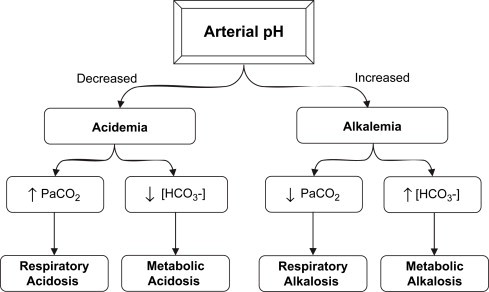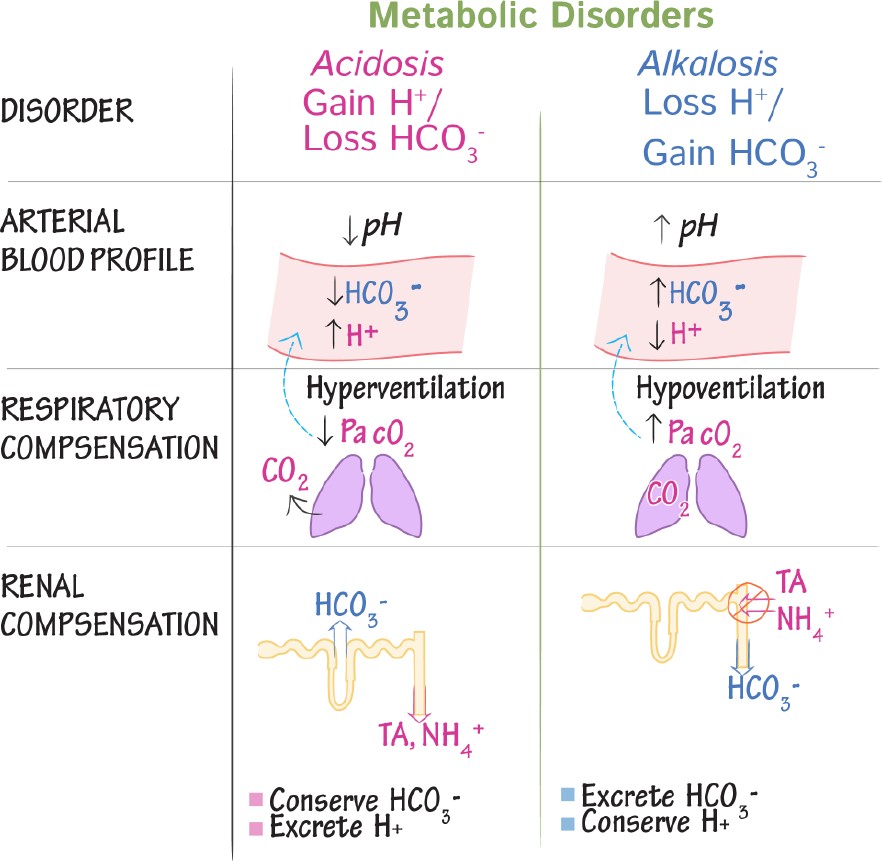A patient's ABG results came back with the following values: pH 7.25, CO2 40, HCO3 22. How would you, as the nurse, interpret these results?
Metabolic acidosis
Respiratory acidosis
Metabolic alkalosis
Respiratory alkalosis
The Correct Answer is A
Choice A reason: Metabolic acidosis is characterized by a low pH and a normal or low HCO3. In this case, the pH is 7.25, which is below the normal range of 7.35-7.45, and the HCO3 is 22, which is at the lower end of the normal range of 22-26 mEq/L, indicating metabolic acidosis.
Choice B reason: Respiratory acidosis is characterized by a high CO2 level. However, in this scenario, the CO2 is 40, which is within the normal range of 35-45 mmHg, ruling out respiratory acidosis.
Choice C reason: Metabolic alkalosis would present with a high pH and a high HCO3 level. Since the pH is low, metabolic alkalosis is not the correct answer.
Choice D reason: Respiratory alkalosis is characterized by a low CO2 level and a high pH. Given that the CO2 is normal and the pH is low, respiratory alkalosis is not the condition indicated by these ABG results.
 |
Nursing Test Bank
Naxlex Comprehensive Predictor Exams
Related Questions
Correct Answer is D
Explanation
Choice A reason: This statement is incorrect; patients have the right to refuse treatment at any time, even after signing the consent form.
Choice B reason: While the charge nurse may review the risks, it is typically the responsibility of the provider performing the procedure to ensure the patient understands the risks involved.
Choice C reason: A witness may be required to sign the consent form, but it does not necessarily have to be the patient's partner.
Choice D reason: It is important for the provider to discuss all treatment options with the patient, so they can make an informed decision.
Correct Answer is C
Explanation
Choice A reason: Metabolic alkalosis is characterized by a high pH and a high HCO3 level, which is not present in this scenario.
Choice B reason: Respiratory acidosis is characterized by a high PaCO2 and a low pH. Although the pH is low here, the PaCO2 is also low, ruling out respiratory acidosis.
Choice C reason: Metabolic acidosis is indicated by a low pH and a low HCO3 level, which aligns with the patient's ABG results.
Choice D reason: Respiratory alkalosis would present with a high pH and a low PaCO2, which is not the case here.

Whether you are a student looking to ace your exams or a practicing nurse seeking to enhance your expertise , our nursing education contents will empower you with the confidence and competence to make a difference in the lives of patients and become a respected leader in the healthcare field.
Visit Naxlex, invest in your future and unlock endless possibilities with our unparalleled nursing education contents today
Report Wrong Answer on the Current Question
Do you disagree with the answer? If yes, what is your expected answer? Explain.
Kindly be descriptive with the issue you are facing.
